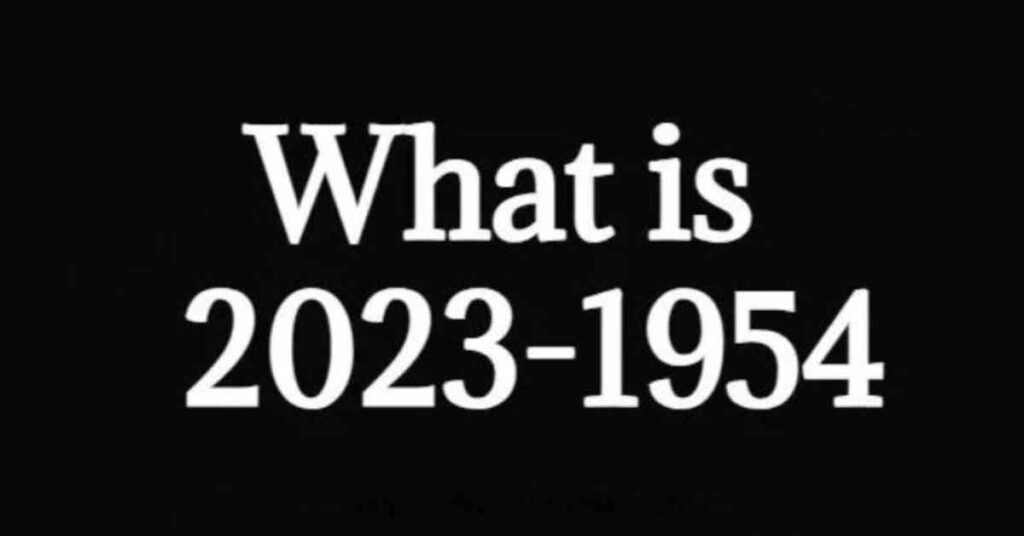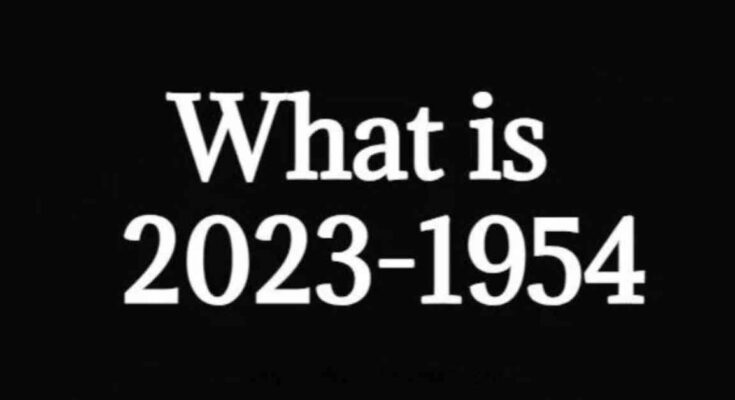Table of Contents
Welcome to a journey through time, where we unravel the fascinating evolution of how humanity has measured and perceived this intangible concept. From ancient civilizations to modern technological advancements, join us as we explore the history of timekeeping and predict the future for our understanding of time. Let’s dive into the depths of 2023-1954: The Evolution of Time.
2023-1954: Time Gap
The time gap between 2023 and 1954 spans nearly seven decades, marked by significant historical events and societal changes. It represents a transition from post-World War II recovery to the digital age of the 21st century. During this time span, advancements in technology have revolutionized how we perceive and interact with time. The cultural shifts and political landscapes that occurred during these years shaped our current understanding of the world around us.
As we reflect on this time gap, it serves as a reminder of the progress made in various fields such as science, medicine, communication, and transportation. The differences in lifestyle, values, and priorities between these two eras highlight the ever-evolving nature of human society. By examining the contrast between 2023 and 1954, we gain insight into how far we have come as a civilization.
2023-1954: 5 Most Memorable Moments
In the year 2023, reminiscing about the past moments of 1954 brings a sense of nostalgia and curiosity. From groundbreaking inventions to historic events, 1954 was filled with memorable milestones. One notable moment was the first successful kidney transplant performed by Dr. Joseph Murray in Boston, marking a significant advancement in medical science.
Another unforgettable event from 1954 was the iconic debut of Marilyn Monroe’s “The Seven Year Itch,” captivating audiences worldwide with her timeless beauty and charm. The Supreme Court’s landmark decision on Brown v. Board of Education also stands out as a pivotal moment in the fight against racial segregation.
On a lighter note, Elvis Presley’s rise to fame with hits like “That’s All Right” revolutionized the music industry and ignited a cultural phenomenon that still resonates today. Roger Bannister breaking the four-minute mile barrier showcased human perseverance and athletic achievement at its finest.
Reflecting on these five memorable moments from 1954 offers a glimpse into an era of innovation, progress, and cultural significance.
How to Calculate the Time Difference Between 2023-1954
Calculating the time difference between 2023 and 1954 may seem complex, but it can be easily done with simple math. First, subtract 1954 from 2023 to get the total number of years between the two dates.
Next, multiply this result by 365 (the average number of days in a year) to determine how many days have passed. Then, consider any leap years that occurred within this period and add an extra day for each leap year.
To calculate the exact time difference down to hours or minutes, you would need to break down further the days into hours, minutes, and seconds using conversion factors. Utilizing online tools or specialized software can also streamline this process for precise calculations without hassle.
Understanding how time differences are calculated satisfies curiosity and sheds light on the intricacies of chronological measurements throughout history.

Introduction to the concept of time
Time is the elusive concept that governs our existence. From the clock’s ticking to the changing seasons, time surrounds us in every moment. It is both a measurement and an experience, shaping how we perceive reality and structure our days.
The idea of time has intrigued philosophers, scientists, and poets for centuries. Is it linear or cyclical? Can it be paused or rewound? These questions fuel endless debates about the nature of time and its role in shaping human consciousness.
As we delve deeper into the complexities of time, we uncover layers of meaning beyond mere seconds and minutes. Time is not just a tool for organizing events; it reflects our mortality and impermanence in this vast universe.
Exploring the concept of time embarks us on a journey through history, culture, and technology. It guides us through mundane and monumental moments, weaving together the fabric of human experience in its ever-changing tapestry.
The history of timekeeping
The history of timekeeping dates back to ancient civilizations, when the sun and moon were used as natural indicators of time. Sundials and water clocks, which relied on the movement of shadows or flowing water, were among the earliest inventions to measure time.
As societies advanced, mechanical clocks emerged in Europe during the Middle Ages, revolutionizing how people tracked time. Galileo Galilei and Christiaan Huygens’ invention of pendulum clocks further refined accuracy in timekeeping.
In the 18th century, John Harrison’s marine chronometer allowed for precise navigation at sea by accurately measuring longitude based on a fixed standard time.
The Industrial Revolution ushered in a new era of standardized time, with railway schedules demanding uniformity across regions. This led to the establishment of global time zones and coordinated universal time (UTC).
Today, atomic clocks are at the forefront of precision timing with incredible accuracy that shapes modern technology and communication systems.
Time in ancient civilizations
Ancient civilizations held diverse beliefs about time. For the Egyptians, the sun’s movement across the sky marked the passage of time. They developed sundials to track hours during daylight. The Babylonians were known for their sophisticated lunar calendars, guiding agricultural activities and religious ceremonies.
In China, the concept of time was intertwined with celestial events like solstices and equinoxes. The Mayans created a complex calendar system based on astronomical observations that spanned thousands of years into the future.
Time in ancient Greece was linked to philosophical ideas about cyclical patterns and eternal recurrence. Philosophers like Plato pondered on the nature of time as a dimension beyond physical existence.
Each civilization’s unique perspective on time reflects their cultural values and understanding of the natural world around them.
The standardization of time through clocks and calendars
Standardizing time through clocks and calendars has been a pivotal development in human history. Before the advent of standardized time, communities relied on sundials, water clocks, and other primitive methods to track time.
However, with the introduction of mechanical clocks in the Middle Ages, people could now synchronize their activities more efficiently. This led to establishing time zones and, eventually, creating internationally recognized systems like Greenwich Mean Time.
Calendars also significantly organized time, with civilizations developing systems based on lunar cycles or solar movements. The Gregorian calendar we use today results from centuries of refinement and adjustment.
The standardization of time through clocks and calendars has profoundly shaped modern society’s structure and organization.

The impact of industrialization on our perception of time
The impact of industrialization on our perception of time has been profound. With the rise of factories and mass production, time became synonymous with efficiency and productivity. Workers were expected to adhere to strict schedules dictated by the rhythm of machines.
As industries grew, so did the need for standardization of time across regions. The introduction of railway networks further emphasized the importance of synchronized schedules for transportation and trade.
Industrialization also led to the division of labor, where tasks were broken down into smaller units to increase output. This shift in work dynamics influenced how individuals viewed their own time and value in relation to productivity.
The clock symbolized control and discipline in the industrial era, shaping societal norms around punctuality and deadlines. Time management skills became essential for success in a fast-paced world driven by economic progress.
Technological advances in time measurement
With the rapid advancement in technology, time measurement has reached new heights. From atomic clocks that are accurate to a billionth of a second to satellite-based systems like GPS, our ability to measure time with precision is unparalleled.
The development of quantum technologies has opened up possibilities for even more precise timekeeping methods, promising accuracy beyond previously thought possible. Quantum clocks can redefine how we understand and measure time in the future.
Furthermore, advancements in artificial intelligence and machine learning have enabled us to analyze vast amounts of data quickly and efficiently, improving predicting and managing time-related processes. These technological innovations continue to shape our understanding of time and its applications across various industries.
Future predictions for the evolution of time
As we look towards the future, the evolution of time is set to undergo remarkable changes. With advancements in technology like AI and quantum computing, our ability to measure time will become more precise than ever before.
We can expect a shift towards more personalized experiences with time management, catering to individual lifestyles and preferences. Time may no longer be seen as a linear concept but rather as a fluid and adaptable resource that can be manipulated.
Integrating biometric data and wearable tech could revolutionize how we perceive time, leading to new ways of optimizing productivity and well-being. Virtual reality environments might offer alternative timelines or realities where time operates differently.
The future holds exciting possibilities for how we interact with and understand time – blending tradition with innovation to create a dynamic temporal landscape ahead.

Conclusion: 2023-1954
As we reflect on the evolution of time from 2023 to 1954, it becomes evident that our perception and measurement of time have undergone significant changes over the years. From ancient civilizations marking time with the movement of celestial bodies to modern technological advancements enabling precise atomic clock measurements, humanity’s relationship with time has been a constant journey of innovation and standardization.
The five most memorable moments between 2023 and 1954 serve as markers in history where time played a crucial role in shaping events and defining eras. Whether it was the invention of digital clocks or standardized calendars, each milestone contributed to how we understand and utilize time today.
Calculating the time difference between these two periods allows us to appreciate how far we’ve come in measuring and managing one of life’s most precious resources. Time is not just a concept but a tangible force that governs our actions, schedules, and interactions with the world around us.
As we look towards the future, further technological advancements will inevitably continue redefining our relationship with time. From artificial intelligence optimizing schedules to biometric devices tracking biological rhythms, new innovations will undoubtedly shape how we perceive and utilize this fundamental aspect of existence.
While the gap between 2023-1954 represents more than just numbers on a calendar, it symbolizes humanity’s unending quest for precision, efficiency, and understanding in an ever-changing world governed by one constant: time.
Latest Posts [https://besaras.com/]










